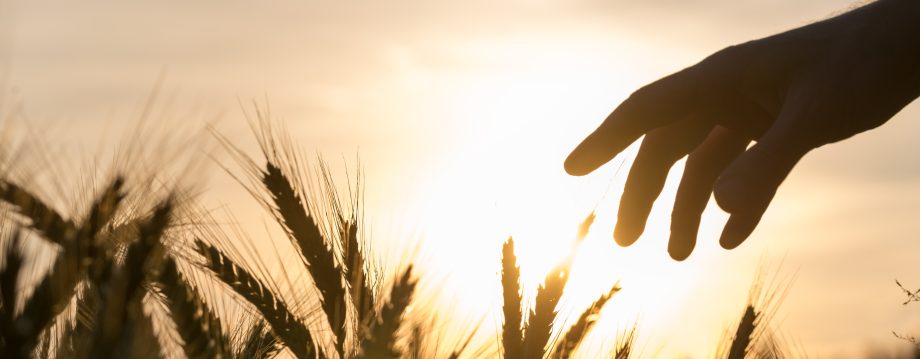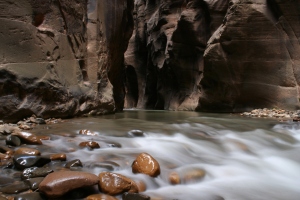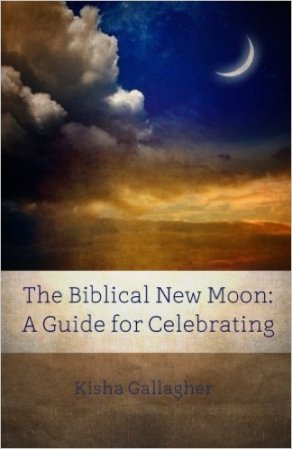For the best context, read Part I and Part II of Miriam’s Cup. This little study on water, the heavens, the Holy Spirit, Miriam, Baptism, and Pesach can only take us to one place: the fountain of Living Waters found in our Messiah! Please join me in drinking deeply from this wonderful well of life.
Before we proceed to the Living Waters and the Messiah, I would like to revisit Baptism or immersing in a Mikvah. While many Christians (falsely) assume that this ritual began in the Brit Chadashah (N.T.), those that have been returning to their Hebraic Roots are fully aware that this custom is far more ancient.
Genesis begins with water and Revelation ends with a river. The Spirit broods over the Creation waters and the angel shows John (Rev. 22: 1-2) a river of water of life, clear as crystal, coming from the throne of God and of the Lamb. Notice that it is the Spirit AND the Bride that say, “Come!” They call to the thirsty and freely allow them to partake of the waters of life (Rev. 22:17). This calling action echoes the woman of wisdom in the Book of Proverbs. Later Solomon compares this woman to a precious fountain.[1]
The words of a man’s mouth are deep waters; The fountain of wisdom is a bubbling brook. (Pr. 18:4)
From the beginning, water has been associated with YHWH’s Spirit. What better imagery is there for the Spirit of God than that which causes all plant life to grow, nourishes all livestock, cleanses our bodies and garments, and sustains our overall well-being? Aryeh Kaplan, in his book Waters of Eden, states that, “Water is the primary connection that we have with the Garden of Eden.”[2] We seem to have been given a mystical link to this truth in the Genesis narrative. (Gen. 2) This story is strangely interrupted by an account of a river that is sourced in Eden. It breaks off into 4 tributaries that surround and water the entire garden. There may be a scarlet thread that runs throughout the Bible, but there is also a river of life — for those that look for it.
There is an old Midrash that has fallen Adam repenting by sitting in a river. Whether or not this is true is not the point. The emphasis is on the cleansing power of water, literally and figuratively. The waters of Eden are the waters that flow from the throne of God. Therefore, physical water is both literally and figuratively a cleanser. This is the same imagery used with Baptism’s washing away sins.[3] We repent because we desire to return to a clean state. Ultimately, our hope is resurrection unto eternal life and a permanent residence in the Kingdom from which crystal waters flow.
Water, Water, Everywhere, but Not a Drop to Drink
Have you ever been on a ship in the ocean so far from shore that you can no longer see land? It’s quite an eerie feeling the first time you experience this wonder. There is an overwhelming sense of smallness and vulnerability. The fear of what would happen if you became stranded is daunting. Perhaps you’ve watched movies or read books where this happened to someone. Not long ago, I watched the Life of Pi where an Indian boy is trapped for weeks on a small life boat with a tiger (he had been travelling with zoo animals on a ship that sank). Though he was surrounded by water, there was not a drop to drink. Dependence on condensation and rain water became a very real source of life for the boy and the tiger.
I think we often feel as (spiritually) thirsty as this unlikely pair. We perceive that the waters of salvation are everywhere, yet here we are dying from dehydration. We scramble to suck up the little bit of condensation we find and pray for rain. What we wouldn’t give to have a river of fresh water to quench our insatiable thirst!
Now, you may believe I’ve described an unbeliever or a lost person, but if you’re like me (human), then you too know this “dry soul” feeling even after coming to Messiah. Whether you find yourself in this place because of sin or because of testing, it is a very real campsite for the people of YHWH.[4] But the good news is that it is a temporary stop along the journey. Once we repent or learn the lesson, He refreshes us with the only thing that can really satisfy our souls, which is the Springs of Salvation, the Living Waters.
Is. 12:1-6 Then you will say on that day, “I will give thanks to You, O LORD; For although You were angry with me, Your anger is turned away, And You comfort me. (2) “Behold, God is my salvation, I will trust and not be afraid; For the LORD GOD is my strength and song, And He has become my salvation.” (3) Therefore you will joyously draw water From the springs of salvation. (4) And in that day you will say, “Give thanks to the LORD, call on His name. Make known His deeds among the peoples; Make them remember that His name is exalted.” (5) Praise the LORD in song, for He has done excellent things; Let this be known throughout the earth. (6) Cry aloud and shout for joy, O inhabitant of Zion, For great in your midst is the Holy One of Israel.
Women and Wells
We live in a world of chaos. The waters offered by the world and false religion leaves us dry and thirsty. But the Father knew this from the very beginning. His Spirit brings order and Living Waters to our chaos if only we will drink. In Genesis, these waters are brooded over by the “woman” of the Holy Spirit. Therefore, we would expect a significant amount of prophetic testimonies to occur at wells (especially with women). Consider the most famous Biblical woman at a well, the Samaritan. Speaking to her, Yeshua says:
John 4:10-14 Jesus answered and said to her, “If you knew the gift of God, and who it is who says to you, ‘Give Me a drink,’ you would have asked Him, and He would have given you living water.” (11) She *said to Him, “Sir, You have nothing to draw with and the well is deep; where then do You get that living water? (12) “You are not greater than our father Jacob, are You, who gave us the well, and drank of it himself and his sons and his cattle?” (13) Jesus answered and said to her, “Everyone who drinks of this water will thirst again; (14) but whoever drinks of the water that I will give him shall never thirst; but the water that I will give him will become in him a well of water springing up to eternal life.“
The Samaritan woman gets all the press as being the “woman at the well” because Yeshua spoke very plainly to her about not only who she was, but who He is! However, that doesn’t mean that her story is the only story of a woman at a well that we should appreciate. In fact, I don’t believe we can fully grasp the Samaritan’s encounter unless we first understand her predecessors. The first century people that heard the testimony of this woman or even those that had just heard a retelling of these events would have had a very specific paradigm in which they would filter this story. That paradigm was the Torah of Moses.
Yeshua’s encounter with this woman is meant to remind you of other stories of women at wells. Have you ever considered that Isaac, Jacob, and Moses all found their WIVES at a WELL of WATER? We’ve already looked at Miriam’s connection to water and wells. I don’t think this repetitive theme is arbitrary. If you are the Bride of Yeshua, He will meet you at a well also. Perhaps this is why so many have a hard time separating Baptism and Salvation.
Yeshua tells the Samaritan woman that He can give her “living water”. What makes water “living”? And why and how does this water become a “well that springs up eternal life” once it is ingested? In order for waters to be considered “living”, they must be moving or flowing. Stagnant or still pools do not have “life” in Hebraic thought. Mayim Chayim (living waters) are characterized by MOVEMENT. Does this remind you of the Spirit of Elohim in Genesis?
We looked at the Song of Songs in the Biblical Role of Women Part III. As we discovered in that post, the imagery in this book is of both a complete and restored MAN and WOMAN. Both are functioning in their purpose and living righteously in the Garden (of Eden). Notice in the verse below that there is yet another association of a woman and life giving water. This is one of the godly functions of the female. A holy and restored woman will reflect the Holy Spirit by giving “water” and nurture to the seed that promotes growth and maturity.[5] Speaking of the woman, the man calls her:
A fountain of gardens, a well of living waters, and streams from Lebanon. (SOS 4:15)
Since the Song of Songs portrays a redeemed man and woman, we could say that both men and women as Yeshua’s Bride are a well of Living Waters. This is, in fact, exactly what Yeshua tells the Samaritan woman. We are often so focused on receiving Living Waters, that we forget that we are to be Living Waters! We water YHWH’s people just as the matriarchs gave drink to the patriarchs and watered the livestock. You are a Spring of Salvation and a fountain of Living Waters, because you belong to Messiah. We already have everything we need, but we still have a choice to make. Will we live it out, today? The choice is ours.
“He who believes in Me, as the Scripture said, ‘From his innermost being will flow rivers of living water.'” But this He spoke of the Spirit, whom those who believed in Him were to receive; for the Spirit was not yet given, because Jesus was not yet glorified. (John 7:38-39)
This truth is why both blood and water gushed from the “side” of Messiah as He hung on the tree. Like the first Adam, Messiah’s Bride comes forth from His side.
But one of the soldiers pierced His side with a spear, and immediately blood and water came out. (John 19:34)
John later describes three things that testify who Messiah is.
It is the Spirit who testifies, because the Spirit is the truth. (7) For there are three that testify: (8) the Spirit and the water and the blood; and the three are in agreement. (1Jn 5:6b-8)
Since Messiah is returning for a Bride of like kind, we also will have these three witnesses: spirit, water, and blood. He meets us at well. We drink from the fountain. Like the Samaritan woman, we drop our water pots and run and witness to as many as we can about Messiah; thus, we become the springs leading others to Salvation. This theme is repeated again and again. We can see it in the Creation Days. We can see it in the Moedim (Feast Days). We can see it in the movement of the 7 Spirits of Elohim (Is. 11:2). The ancient matriarchs teach us how to be His Majesty’s Bride. We first give water to the patriarchs (minister to YHWH), and then we water the livestock (YHWH’s people). This is the essence of the Cup of Miriam.
Applying the Cup
Miriam’s Cup is filled with WATER, not wine. Wine can represent joy, judgment, or even the blood of Messiah. But there are three that testify. Water symbolizes both mayim and the Holy Spirit. By incorporating the Cup of Miriam into our Seder or even our weekly kiddush, we partake of all three symbols. Since the Cup of Elijah comes near the end of the Seder, we include the Cup of Miriam just after the candle lighting. This way, our four cups of wine will be flanked by the prophetess Miriam and the prophet Elijah. Miriam will represent the presence of the Holy Spirit in our lives as we are continually watered and washed by the Word as we journey throughout this life, and Elijah will remind us of our coming complete redemption at the Messianic Age.
Hopefully, Miriam’s Cup will be a spring board for you to do more study. I would love to hear your thoughts on this tradition and any “connections” you may find. What does Miriam mean to you? How will can Miriam contribute to your families’ understanding of the Exodus?
Haggadah Ideas
- After the women (or a woman) lights the Shabbat Candles, Have everyone partake of the WATER of Miriam’s Cup. Explain all the wonderful imagery in the patriarchs meeting their brides at wells.
- Correlate this with the Holy Spirit, Baptism, the Springs of Salvation, Yeshua’s pierced side, the 3 that testify, and the Living Waters.
- Relate all of this imagery with Pesach and Sukkot (The beginning and the end).
- Praise YHWH for the women at your Seder and their contribution in rebelling at Pharaoh’s evil decrees.
- Praise Yeshua for choosing you to be a spotless Bride.
[1] Proverbs 9:1-6
[2] Kaplan, Aryeh, Waters of Eden, New York (2003) p. 35
[3] ‘Now why do you delay? Get up and be baptized, and wash away your sins, calling on His name.’ (Acts 22:16)
[4] Remember the bitter waters at Marah? They were to test the people.
[5] Dr. Skip Moen teaches that the “living waters” provided by the woman are also a picture of her role as the ezer kenegdo: http://skipmoen.com/2009/11/28/connections/









